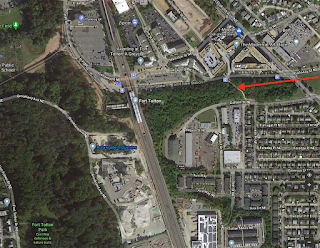"During the war, there was no military research more urgent or secret than what took place in this corner of the District,” USACE Col. Estee Pinchasin said. About 1,500 chemists, scientists and soldiers worked at what was known as the American University Experiment Station to research chemical warfare in 1917 and 1918. When the war, ended many of those weapons and chemicals were buried in what is now one of the most expensive neighborhoods in D.C. ... The biggest deposit was at 4825 Glenbrook Road. “The team discovered seven different chemical agents, six other chemicals that had unique military applications,” Pinchasin said. “And Glenbrook Road was the only site in the United States where weaponized arsine was encountered in 75 mm projectiles.”
Dec 21, 2021
WWI Chemical Weapons Cleanup Completed at 4825 Glenbrook Rd
Nov 9, 2021
Army Will Chase AUES Debris into Hill Alongside PSB Next Year
The findings of the test pit and rotosonic investigations indicate that additional excavation is warranted to remove the AUES debris that was encountered in soil west, north, and east of the Public Safety Building footprint. The goal of the PSB slope investigation was to determine the extent of continuous AUES debris extending from the PSB excavation sidewalls. An area of continuous AUES debris was indicated to the west (approximately 12 feet from the former PSB foundation), to the east (approximately 16 feet from the former PSB foundation), and to the north (approximately 15 feet from the former PSB foundation). This area also corresponds to soil benches 4 and 5, where AUES debris was encountered during the excavation in 2019 ... [The proposed soil and AUES debris excavation area] would involve the excavation and removal of an estimated in-place volume of 720 cubic yards of soil and AUES debris ... Prior to excavating a specific area, a UXO Tech III will sweep the planned excavation area with a magnetometer ... Any identified MEC items or intact AUES items will be handled in accordance with the Low Probability Contingency Plan [pg. 15].
Weston Solutions, Inc.
PSB Slope Investigation Report
June 23, 2021 (pgs. 10 & 11)
USACE sent out a "Request of Proposal" dated July 21 2021 to complete excavation of AUES debris east, north and west of the former PSB foundation. Proposal was submitted on 8 September 2021. The proposed soil to be excavated is presented in the [slide below]; the area is based on the test pit and Rotosonic soil borings completed at the PSB site in April 2021. To safely conduct the soil slope excavation north of the former PSB foundation, a soil retaining wall is recommended ... The planned upslope excavation at RS-04 would be conducted using a slide rail shoring system.
Based on the investigation results, USACE determined the scope of work to excavate the extent of AUES debris identified. Once funding has been obtained and the work awarded, additional plans will be required before re-starting the soil remediation work. This will entail a delay of many months before the work is awarded and the required planning documents are prepared and approved. Slope Soil Removal not expected to begin until winter/spring 2022.
Spring Valley RAB
PowerPoint Presentation
November 9, 2021 (pgs. 21 & 23)
Sep 13, 2021
Info Sought from Park Service on Spring Valley Dumping in 90's
May 25, 2021
Despite Unrecovered Munitions, RAB Contemplates Dissolution
Spring Valley RAB
Meeting Minutes
May 11, 2020 (pg. 11)
National Park Service: The NPS anticipates construction of the Fort Circle/Fort Totten Pedestrian Trail, located between Gallatin Street NE and Galloway Street NE, will resume this summer. Soil testing indicates the trail area is safe for people and animals. For the safety of the public, the area will continue to be closed off through the completion of the construction project. To further ensure safety, a specialized contractor will test the soil for any evidence of unexploded ordnance during construction activities.
Q & A
Norton-NPS Town Hall
March 25, 2021 (pgs. 4 - 5)
Spring Valley RAB
Meeting Minutes
March 10, 2020 (pg. 13 - 14)
Apr 28, 2021
AUES Debris Under Hill Next to PSB Won't Be Removed until 2022
Spring Valley FUDS
Spring Valley RAB
Meeting Minutes
March 9, 2021 (pgs. 11 - 12)
Spring Valley FUDS
Partnering Meeting
February 19, 2021 (pgs. 35, 40 & 42)
















